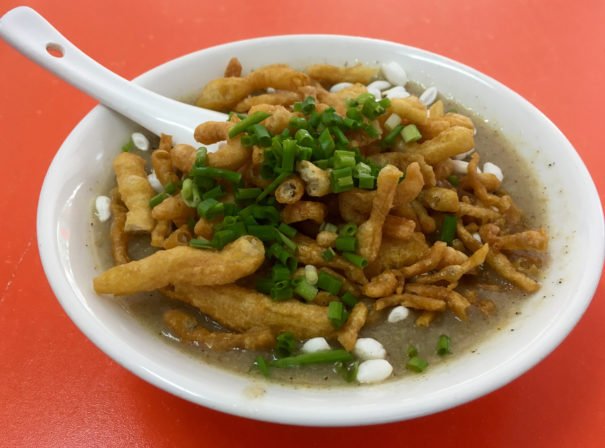
Disregard the Ghastly Color and Lumpy Texture And This Porridge Is Actually Quite Good

Disregard the Ghastly Color and Lumpy Texture And This Porridge Is Actually Quite Good
Youcha Tang in Meitan
Meitan County, in southern China’s Guizhou province, is obsessed with tea. At the center of the county seat, on the peak of a hill named Fire Mountain, sits a 240-foot-tall building shaped like a teapot. Another township features a series of undulating tea fields called the “Sea of Tea,” named after an impromptu utterance by former president Hu Jintao. The character for tea adorns unassuming housing blocks and grand entryways alike, and even the streetlights overlooking the county’s recently paved extra-wide highways are shaped like tea leaves. Places in China often compete to be number one for something, and Meitan has crowned itself the undisputed number one place for tea in Guizhou.
You don’t need to drink tea with breakfast in Meitan, because you can get tea in your breakfast. Youcha tang, or oil tea soup, is a thick porridge made with tea leaves, sticky rice, peanuts, and lard. The ghastly grayish-green color and lumpy, viscous texture are misleading: adorned with fried dough twists and crispy millet, oil tea soup has a pleasant, slightly salty taste. Each variation of oil tea soup has different ingredients, but when I press for more specifics about what is in the bowl I am eating, I am simply told, “A lot of things.”
In Meitan, oil tea soup has earned the moniker “vitality soup.” “If you eat a bowl of oil tea soup in the morning, you’ll have vitality all day,” explains Bacon, my tour guide-turned-best friend who, like nearly everyone I meet in Meitan, takes hospitality to unparalleled heights. The origins of oil tea soup are murky, but local lore traces it back more than a century and a half, to the food that helped re-energize rebel forces fighting against the Qing dynasty army. The thick porridge is about as efficient as caloric intake gets, and it tastes pretty good, too.
Much of the rest of the tea obsession in Meitan, in which any possible item can be turned into an oversized monument to tea, is new. A decade ago, a friend explains, there was still plenty of tea in Meitan—it just wasn’t a big deal. Policymakers hope that combining tea and tourism can drive economic growth in what remains one of the least developed parts of the country.
The newfound overabundance of tea symbolism has succeeded in drawing people like me, strangely fascinated by giant teapot buildings, to Meitan. But something feels off about the extent to which tea has metastasized in Meitan. Similar to brand-new “ancient” towns sprouting up all over China, the single-minded obsession with tea feels forced: the need to make a place “about something” threatens to overshadow the essence of the place itself.
A dish like oil tea soup dispels any doubts about Meitan. It is the most utilitarian food imaginable, eaten by farmers and office workers alike. High-grade tea can be outrageously expensive, but a hearty bowl of oil tea soup remains less than a dollar. It, rather than the world’s largest teapot, would be a better choice to represent the people and places in Meitan: humble, nourishing, and surprisingly delightful.